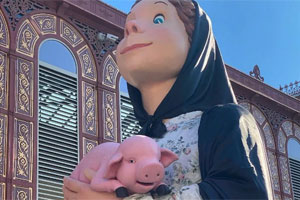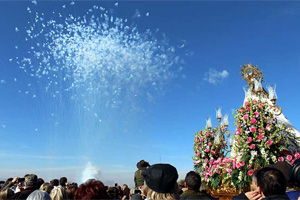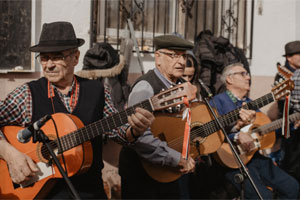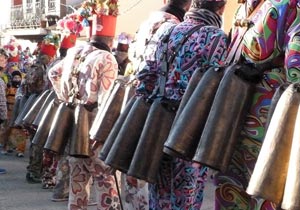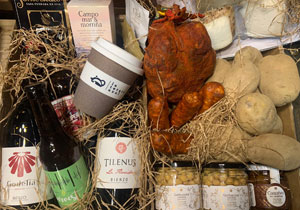Caracolá Lebrijana
What is the Caracolá Lebrijana?
Flamenco is the most prominent cultural manifestation of Andalusia on an international level, requiring strong institutional commitment and social awareness due to its cultural value and economic importance. The oral tradition of flamenco has been passed down through generations in Gypsy families from Cádiz and Seville, which has been vital for its unique musical identity. Lebrija is recognized as one of the centers of flamenco singing, where the rhythm is never lost, and it has been the birthplace of great artists in singing, guitar playing, and dancing.
The Caracolá de Lebrija is one of the oldest existing flamenco festivals and has been celebrated since 1966. It emerged with the aim of promoting flamenco culture to the people of Lebrija and enthusiasts in general. Over the years, it has evolved and adapted to the times, currently featuring parallel activities that extend throughout an entire week. The usual venues include the Casa de la Cultura, the Pepe Montaraz flamenco club, and the Plaza del Hospitalillo. The festival has been a stage for prominent artists in singing, guitar playing, and dancing, some of whom have already passed away, but their legacy lives on in the city of Lebrija, which is considered the birthplace of authentic flamenco.
The festival has paid tribute to important figures in flamenco such as Juan Peña "El Lebrijano" and Curro Malena, naming them Honorary Citizens of the city. Throughout its history, it has featured the participation of numerous emblematic artists, including Lebrijano, Miguel Funi, Camarón de la Isla, Antonio Mairena, José Mercé, Carmen Linares, Marina Heredia, Arcángel, Pitingo, Remedios Amaya, among many others. The Caracolá de Lebrija has been recognized as one of the most important festivals in Spain and has overcome various obstacles to maintain its tradition and remain a reference in the world of flamenco.
Since 1966, the Lebrija City Council has been committed to promoting flamenco by initiating a festival to spread flamenco culture among the people of Lebrija and enthusiasts in general. This objective remains current, and its essence is preserved. The brand "Flamenco de Lebrija" represents both flamenco created in Lebrija and all activities related to this art form, connecting artists from the past, present, and future. The City Council continues to work in collaboration with individuals, artists, and organizations to develop a comprehensive flamenco program that addresses the questions posed and keeps this artistic expression alive, an inseparable part of Lebrija's culture.
History of the Caracolá Lebrijana
The first edition of the Caracolá Lebrijana took place on September 9, 1966, thanks to a group of flamenco enthusiasts with the aim of promoting flamenco culture among the people of Lebrija and enthusiasts in general. This historic festival, called the "Iª CARACOLA LEBRIJANA," was dedicated to the figure of "JUANIQUÍ" and featured the participation of renowned artists such as Juan Peña "El Lebrijano," El Borrico, Miguel Funi, Perrate, Pedro Peña, Manuel Jaro, Parrilla, Manolito María, and many others. Over the years, this flamenco event has been held uninterrupted and has established itself as one of the most important in Spain, overcoming unforeseen challenges and maintaining its place in flamenco history.
The festival has featured the participation of numerous prominent artists in singing, guitar playing, and dancing, leaving their mark on the history of flamenco. Although some of them are no longer with us, their legacy lives on in Lebrija, the birthplace of authentic flamenco. Among the artists who have participated, we can mention Lebrijano, Curro Malena, Miguel Funi, Manuel de Paula, Camarón de la Isla, José Mercé, Marina Heredia, Arcángel, Pitingo, Pedro Bacán, and many more. The festival has celebrated significant milestones, such as the appointment of Juan Peña "El Lebrijano" as Honorary Citizen of Lebrija in 2009 and the tribute to Curro Malena in 2011.
Celebration Venues
The Caracolá has sought different venues to accommodate artists and their passionate audience since its inception. Recently, the use of existing cultural infrastructures such as the Municipal Theater has been proposed for the most prominent performances, while also taking advantage of the city's heritage spaces. The municipality aims to maintain the connection between tangible and intangible heritage, and this proposal seeks to bring both elements together in the festival.
These are some of the spaces that host the various performances that make up the programming of the Caracolá Lebrijana:
- Patio of the Ajudisle headquarters.
- Patio de los Naranjos, of the Parish of Nuestra Señora de la Oliva.
- Patio and cellar of the Casa del Marqués de San Gil.
- Rooftop of the Pepe Montaraz Flamenco Club.
- Patio of the Flamenco Interpretation Center.
- Patio of the Casa de la Cultura.
- Patio of the former Convent of the Parish of Santa María de Jesús.
- Juan Bernabé Municipal Theater.
- Convent of San Francisco.
- Patio of the Clavería of the Parish of Nuestra Señora de la Oliva.
What to see in Lebrija
In Lebrija, a city located in the province of Seville, there are several places of interest to visit. Here are some recommendations on what to see in Lebrija:
- Santa María de la Oliva Church: This church is one of the main landmarks of Lebrija. Built in the 15th century, it combines Gothic, Mudéjar, and Renaissance elements in its architecture. Its facade and tower are particularly remarkable.
- Palacio de las Cigüeñas: This palace, also known as Casa de los Marqueses de Arcos, is a historic building with Renaissance architecture. It houses the City Museum, where archaeological pieces and art related to the history of Lebrija are exhibited.
- Plaza de España: Located in the center of Lebrija, Plaza de España is a lively and picturesque square. Here you will find bars, restaurants, and shops, as well as a statue dedicated to the famous flamenco singer Juan Peña "El Lebrijano."
- Convent of the Sisters of the Cross: This convent, founded in the 20th century, is a place of great religious importance in Lebrija. Its church features a beautiful image of the Virgin of Solitude, the patron saint of the city.
- Tile Museum: Located in a former olive mill, the Tile Museum displays a collection of tiles and ceramics, reflecting Lebrija's tile-making tradition throughout the centuries.
- Route of the Courtyards: During spring, the Route of the Courtyards is celebrated in Lebrija, where residents open the doors of their courtyards to showcase their beauty and decoration. It's an opportunity to appreciate the typical architecture and beautiful gardens of Lebrija.
These are just some of the attractions you can explore in Lebrija. The city, as seen in this article, also has a rich flamenco tradition and delicious cuisine, making it an attractive destination for culture and history lovers.
Recommended Crafts and Shopping
In Lebrija, you will find a variety of crafts and local products that reflect the tradition and charm of the region.
- Ceramics: Ceramics are highly valued craftsmanship in Lebrija. You can find beautiful hand-painted ceramic pieces such as plates, tiles, vases, and decorative objects with traditional and colorful designs.
- Embroidery and Lacework: The city is known for its tradition of embroidery and lacework. In local shops, you can find items such as mantillas, handkerchiefs, tablecloths, and traditional dresses that showcase the skill and detail of these crafts.
- Flamenco Art: Lebrija has a strong flamenco tradition, so you can find artworks related to flamenco, such as paintings, photographs, and sculptures that capture the essence of this musical genre.
- Local Food Products: You shouldn't miss trying the local products of Lebrija, such as extra virgin olive oil and wines from the region. You can also find honey, jams, and other products derived from local agriculture.
- Leathercraft: Leatherwork is another prominent craft in Lebrija. You can find handmade leather products like bags, belts, wallets, and shoes that reflect the skill of local artisans.
Remember to explore the local shops, markets, and craft fairs in Lebrija to discover authentic local products and support the region's artisans.
What to Eat in Lebrija
Lebrija's gastronomy is characterized by traditional and flavorful dishes that reflect the rich culinary culture of the region. Some of the typical and popular dishes of Lebrija include:
- Gazpacho: A common cold dish throughout Andalusia. It is made with tomatoes, cucumbers, peppers, garlic, olive oil, and vinegar, and served as a refreshing option during the summer months.
- Spinach with Chickpeas: This dish is a classic combination of spinach, chickpeas, garlic, onion, and spices. It is a comforting and tasty dish, considered a staple of Lebrija's traditional cuisine.
- Fried Fish: Since Lebrija is located near the coast, it is common to find a variety of fresh fish and seafood in its gastronomy. Fried fish is very popular, especially anchovies and sole.
- Snails: Snails are a traditional dish in the region, and Lebrija is no exception. These mollusks are cooked in a flavorful sauce with spices and herbs, creating a comforting and delicious dish.
- Shrimp Fritters: This is an Andalusian specialty also found in Lebrija. They are thin fritters made with a mixture of wheat flour and small shrimp, fried until crispy.
- Traditional Sweets: When it comes to desserts, Lebrija has a selection of traditional sweets to try. Highlights include tortas de aceite (olive oil cakes), torrijas (slices of bread soaked in milk and then fried), pestiños (fried pastries covered in honey), and buñuelos (fritters).
These are just some examples of the typical and popular gastronomy of Lebrija. The city offers a variety of traditional dishes that highlight the flavors and culinary influences of the Andalusian region.

